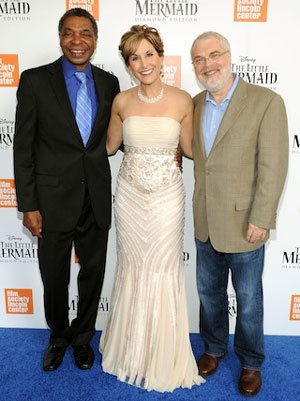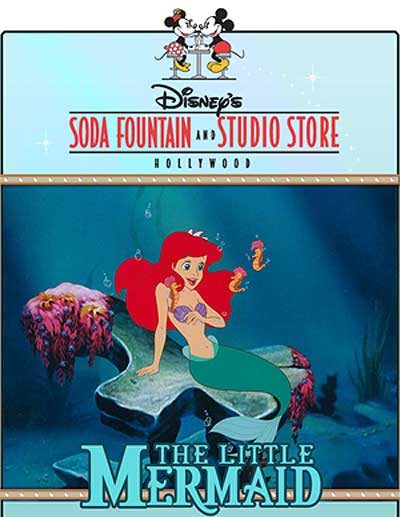In case you haven't already noticed, we're right in the
middle of The Walt Disney Company's full-court promotional press for "The
Little Mermaid" (which is available for the first time on Blu-ray combo
pack and HD Digital starting next Tuesday, October 1st).
So on the East Coast of the country this past Saturday, Walt
Disney Studios Home Entertainment staged a special screening of this beloved
animated classic at NYC's Walter Reade Theater where Jodi Benson (voice of
Ariel), Samuel Wright (voice of Sebastian) and Ron Clements (writer/producer) all
strolled down the blue carpet.

(L to R) Samuel Wright, Jodi Benson
and Ron
Clements. Copyright Disney Enterprises, Inc.
All rights reserved
Meanwhile, out on the West Coast of the country, the El
Capitan Theatre is getting ready to celebrate the Diamond Edition in-home
release of this 1989 Walt Disney Animation Studios production by offering a
limited edition, hand-painted 12 field cel which features Ariel.

Copyright Disney Enterprises, Inc. All rights reserved
And while it's fine that this Ron Clements & John Musker
movie is once again in the spotlight and people are once again praising Howard
Ashman & Alan Menken's Oscar-winning score, I think it's important to
remember that if it weren't for the extraordinary work that Glen Keane &
his team of animators did on "The Little Mermaid," it's doubtful that
any of animation fans would ever fallen in love with the character of Ariel.
Back last month, I was lucky enough to get a chance to chat
with Glen at the D23 EXPO just before he went onstage at the Anaheim Arena to receive
his Disney Legend award. And at that time, I mentioned to Keane that I had
always been impressed with the work that he & his team had done on
"The Little Mermaid." That Ariel had been such a break-through
character for Walt Disney Animation Studios because she was an 16 year-old girl
who actually looked & moved like a 16 year-old girl. And the guy positively
beamed when I passed along that compliment.
"That's great to hear. Because with every character that I've ever drawn,
I have wanted to prove to the audience that they were real. That these
characters are not just drawings," Glen explained. "This is why I
always shaded my animation drawings. Because I want you to feel like you could
actually put your hands around these characters."
Copyright 2013 Brigantine Media. All rights reserved
Mind you, Keane didn't personally animate every scene featuring Ariel in
"The Little Mermaid." But as Steve Hickner points out in his terrific
new book, "Animating Your Career
" (Brigantine Media, August 2013),
Glen made sure that the scenes that he did personally animated really counted.
"And how did Keane select the scenes that he'd personally animate?,"
you ask. As Steve explained …
Some films, such as "The Little Mermaid," have
about fifteen sequences, while other films, such as "Bee Movie
," have
over forty sequences. Each sequence is subsequently divided into discrete
shots. Some of these shots last less than a second, while others might be over
a minute long. The average eighty-minute animated film is compromised of about
1,300 individual shots. While every shot in the film is important, some of the
shots require special attention as defining moments.
Glen Keane working on the title character of "The Little Mermaid" back in 1988.
Copyright Disney Enterprises, Inc. All rights
Even though an animator will work on a film for perhaps a year and a half to
two years, he/she will only be able to animate a small portion. An artist could
make a decision to focus on the details of the story and animated every shot
for just one sequence in the movie, but his impact as a key animator on the
film would be localized to a small portion of the story. The big impact
animators, like Glen Keane, know how to make their work count so the audience
feels their presence in the film. Keane selects what he feels are the most
essential parts of the whole story and focuses his attention on them. But how
does Keane make his choices?
When Keane starts a film, the first and most important decision he will make
will be in choosing which character he will focus on to animate. On "The
Little Mermaid," Keane decided to spend his time on the lead character,
Ariel. He knew that Ariel provided him with two distinct challenges: sometimes
she would be a mermaid and swim like a fish, and other times, she would be a
human and walk on talk feet.
After choosing the character, he next decided on which particular sequences
were most important to him. One of the sequences that Keane chose to animate
was the section of the story where Ariel declares her wishes in the song,
"Part of Your World."
Copyright Disney Enterprises, Inc. All rights reserved
By evaluating every shot in the movie and pinpointing which ones merited his
personal attention, Keane influenced the handling of the character Ariel in the
entire movie. Keane's impact on the movie radiated outward like a pebble that
is dropped into a pond — from the specific (a shot) to the general (the entire
movie).
And Keane then backed up what Hickner had
written in "Animating Your Career" when he & I talked in August.
Glen went into great detail about the sculptural animation that he had done at
the very start of "Part of Your World."
Take another look at the very start at that musical number. Right after Ariel
finishes singing "Wouldn't you think that I'm the girl who has
everything," we then begin to turn this character in space. Now you have
to remember that this is the early, early days of CG. So when Ariel's singing
"Look at this trove, treasures untold. How many wonders can one cavern
hold?" and the camera seems to be spinning around her, that's not actually
a CG camera move. That scene is all done with hand-drawn animation which took
forever to get right.
Copyright Disney Enterprises, Inc. All rights reserved
But in the end, all of that extra effort was worth it. Because it's this moment
in that movie where the audience stops thinking of Ariel as an animated character.
As some drawing. It's this exact moment — thanks to Howard & Alan's
beautiful song and the talented people who cleaned up my rough animation drawings
& then painted those cels — that the audience starts thinking of Ariel as
this real, living thing. A girl who's dreaming of something more. And since so
many of us feel just like that, we dream of something more, that's when the
audience falls in love with this character.
And speaking of something more, it saddened a lot of people
last March when Keane announced that he was leaving Walt Disney Animation
Studios. Effectively stepping away from his home for the past 38 years. And
many animation fans wondered what Glen would wind up doing next after he exited
the Mouse Factory.
Well, when Keane and I talk last month, he revealed that
…
Photo by Jim Hill
I'm just about to start a little company. Glen Keane
Productions. I'm starting very small with animation, drawings and the like. I'm
about to start working on a new project that I really can't start talking about
yet. But I've got some ideas.
So there you have it. Even as the world is once celebrating all of the effort
& artistry that went into the animation & creation of Ariel in Disney's
"The Little Mermaid," the man behind this much beloved character is
about to pick up his Blaisdell Layout pencil once more. Which is the best bit
of animation-related news I've heard in a long, long time.
Your thoughts?
